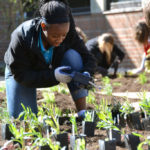The Wabash River Watershed
The Wabash River, which is Indiana’s state river, has a rich economic and cultural history. As a tributary of the Ohio River, it is part of the upper reaches of the 1,245,000-square-mile Mississippi River Basin, and so was a vital navigation and trade route for French traders traveling between Canada and the Gulf of Mexico. Erosion caused it to become impassable for ships in the late 19th century, but it is still vital to the economy, history, and culture of the region. The name Wabash is the Anglophone version of the Miami-Illinois Native American name for the river, Waapaahšiiki, which means “white-shining” or “water over white stones”. The river is so named for its distinctive limestone bed. It provides habitat for unique wetlands plants and a wide variety of wildlife, including the American Bald Eagle.
Direct Impacts on the Watershed
The same erosion and stormwater runoff that rendered the Wabash impassable to ships also harmed native wildlife and reduced water quality. Through water quality testing, the Wabash River Enhancement Corporation (WREC) of Lafayette, IN, found the river impaired by runoff from combined sewer overflows, industrial and municipal wastewater inputs, brownfields, developments, and agricultural runoff. Since 2004, WREC has partnered with Purdue University, the city of Lafayette, West Lafayette, and Tippecanoe County to develop a variety of programs and projects that directly address water quality issues and engage communities along the river. These include the Paint the Rain rain barrel program, Wabash Riverfest, TippEcoNow, and the Wabash Sampling Blitz. WREC relies extensively on its partnerships with community organizations, academic institutions such as Purdue University, schools, businesses, and more. As part of the Urban Waters Learning Network, WREC regularly exchanges expertise with other practitioners from around the country, building on ideas and experiences to improve strategies for community engagement and outreach.

WREC’s Paint the Rain program used rain barrel painting competitions to teach students and community members about the uses and impacts of rain barrels. Photos provided by WREC.
WREC’s methods have proven extremely effective, resulting in significant economic, behavioral, and environmental impacts in the Wabash Watershed. WREC calculates that it is has engaged 1,500 urban residents, 2,900 community members, 85 partners, and nearly 500 Purdue University students to install more than 1,600 rain barrels, nearly 100 rain gardens, 21 acres of pervious pavement, 2 green roofs, more than 5,500 urban trees, 83 bioswales, and 2 urban retrofits. These projects have been completed with 6,400 volunteers providing more than 140,000 hours of volunteer time. Surveys indicate that these activities have improved public awareness about contaminants in the Wabash River, while also empowering residents to directly improve water quality using Best Management Practices (BMPs). According to WREC, the implementation of BMPS has resulted in significant environmental impacts, including:
- More than 655,323 lbs of nitrogen load reduction, 276,350 lbs of phosphorus load reduction, and 21,062 tons of sediment reduction;
- 99,445,000 gallons of unfiltered stormwater prevented from directly entering the Wabash River, thereby saving nearly $3.4 billion in future sediment removal and stormwater treatment costs.
Program Highlights
WREC led the installation of residential BMPs at the Cary Home for Children, a treatment center providing services for low-income families. Thanks to WREC’s Cost Share program, Cary Home was able to install a native savannah garden, a rain garden, and a rain barrel. Volunteers replaced turf grass with native plants, providing educational value to the space, habitat for pollinators, and filtering captured stormwater. This project was part of a four-year program involving several partners, including Cary Home, Bauer Family Resources, and a science museum called Imagination Station. Partners identified areas that needed improvement, studied the flow of stormwater at these sites, participated in designing solutions, and implemented those solutions through volunteer events. Projects like this enable Lafayette residents to connect watershed health with daily life, while directly improving and beautifying their own neighborhoods, homes, and workplaces. WREC believes that these kinds of personal impacts are vital to improving watershed health, because once people understand how environmental issues affect them directly, they are more likely to spread this knowledge within their own personal networks. See “Restoration spotlight: converting turf grass to native plants” for more information about this project.
- Volunteers plant a rain garden using native plants. Photos provided by WREC.
The Future of WREC Projects
WREC continues to implement BMPs in “high-profile” areas, meaning locations that are highly visible and reach a large number of people. This strategy has enabled WREC to leverage small-scale and low-cost projects into dramatic measurable impacts, while also building beneficial relationships with a wide variety of partners, including churches, schools, research institutions, businesses, and more. Despite funding challenges, WREC is optimistic about building on current relationships, developing new connections with high-profile partners, and further improving health, recreation, education, and economic development opportunities in the Wabash River Watershed.
References and Further Reading
Peel, Sara and Lindsey Payne. 2016. Engaging Stakeholders in Small Projects for Big Impacts in the Wabash River Watershed. Purdue University.





